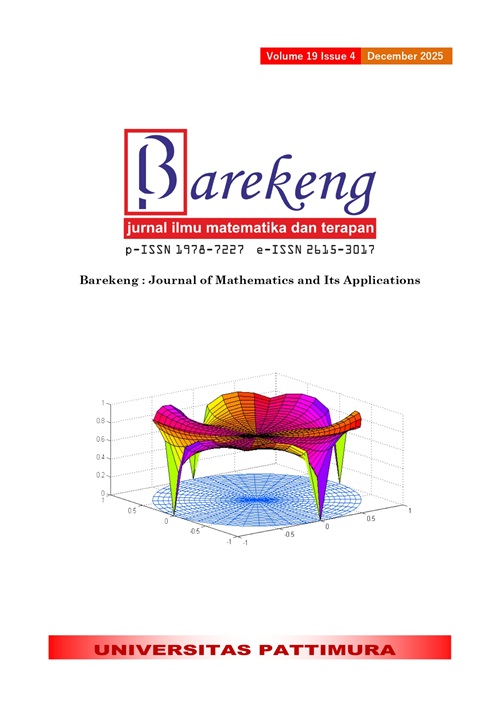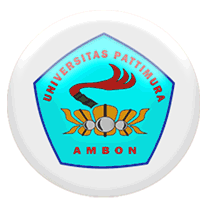SEIR MODELING OF TUBERCULOSIS TRANSMISSION WITH VACCINATION: ESTIMATING THE MINIMUM COVERAGE REQUIRED FOR ELIMINATION IN NORTH SUMATERA
Abstract
Tuberculosis (TB) remains one of the most significant public health challenges in Indonesia, particularly in North Sumatra Province, which records a relatively high prevalence rate. e–Exposed–Infectious–Recovered) A framework to analyze TB's transmission dynamics and evaluate vaccination's effectiveness as an intervention strategy. The primary objective of this research is to estimate the minimum vaccination coverage required to eliminate TB from the population. The model was built by incorporating vaccination rate parameters into the SEIR mathematical model and applied using regional epidemiological data obtained from the North Sumatra Central Bureau of Statistics. A deterministic approach is employed to simulate the system and derive the basic reproduction number ( ), which serves as an indicator of disease persistence across various levels of vaccination coverage. The results of numerical simulations performed using 4th-Order Runge Kutta indicate the existence of a critical vaccination threshold required to reduce below the one-condition that theoretically represents the possibility of disease elimination from the population. These findings provide a quantitative basis for formulating more targeted, data-driven vaccination policies. Calculations based on real-world data reveal that the current R₀ value in North Sumatra remains above one ( ), suggesting that TB continues to pose a risk of remaining endemic. Simulations were also conducted by varying the vaccination coverage while assuming a constant transmission rate, indicating that a minimum of 87.5% vaccination coverage is required to suppress R₀ below the critical threshold. This study underscores the importance of employing mathematical modeling as a decision-support tool in public health policy. The findings deepen the understanding of TB transmission dynamics and offer a robust quantitative foundation for setting vaccination targets for disease elimination in endemic areas such as North Sumatra.
Downloads
References
T. Mobaderi, A. Kazemnejad, and M. Salehi, “CLUSTERING AND MODELING JOINT-TRAJECTORIES OF HIV/AIDS AND TUBERCULOSIS MORTALITY RATES USING BAYESIAN MULTI-PROCESS LATENT GROWTH MODEL: A GLOBAL STUDY FROM 1990 TO 2021,” BMC Infect Dis, vol. 25, no. 1, p. 330, Mar. 2025, doi: https://doi.org/10.1186/s12879-025-10715-x
E. Osei et al., “IMPACT OF COVID-19 ON TUBERCULOSIS AND HIV HEALTH SERVICES DELIVERY IN GHANA: QUALITATIVE EVIDENCE FROM THE PERSPECTIVES OF HEALTHCARE PROVIDERS,” BMC Health Serv Res, vol. 25, no. 1, p. 358, Mar. 2025, doi: https://doi.org/10.1186/s12913-025-12487-1
J. Andrawus et al., “A MATHEMATICAL MODEL OF A TUBERCULOSIS TRANSMISSION DYNAMICS INCORPORATING FIRST AND SECOND LINE TREATMENT,” Journal of Applied Sciences and Environmental Management, vol. 24, no. 5, pp. 917–922, Jun. 2020, doi: https://doi.org/10.4314/jasem.v24i5.29
S. V Gordon and T. Parish, “MICROBE PROFILE: MYCOBACTERIUM TUBERCULOSIS: HUMANITY’S DEADLY MICROBIAL FOE,” Microbiology (N Y), vol. 164, no. 4, pp. 437–439, 2018, doi: https://doi.org/10.1099/mic.0.000601
W. H. Organization, “GENEVA: WORLD HEALTH ORGANIZATION,” 2023.
M. Rastegar, V. Fakoor, E. Nazar, M. Nasehi, S. Sharafi, and M. T. Shakeri, “EFFECTIVE REPRODUCTION NUMBER OF SMEAR-POSITIVE PULMONARY TUBERCULOSIS IN IRAN: A REGISTRY-BASED STUDY (2011-2021),” J Res Health Sci, vol. 24, no. 4, p. e00633, Sep. 2024, doi: https://doi.org/10.34172/jrhs.2024.168
Misnadiarly, PENYAKIT INFEKSI TB PARU DAN EKSTRA PARU MENGENAL, MENCEGAH, MENANGGULANGI TBC PARU, EKSTRA PARU, ANAK, PADA KEHAMILAN OLEH MIUSNADIARLY. Jakarta Pustaka Populer Obor, 2006.
A. K. Mengistu and P. J. Witbooi, “MODELING THE EFFECTS OF VACCINATION AND TREATMENT ON TUBERCULOSIS TRANSMISSION DYNAMICS,” J Appl Math, vol. 2019, pp. 1–9, Dec. 2019, doi: https://doi.org/10.1155/2019/7463167
T. R. Nandi, A. K. Saha, and S. Roy, “ANALYSIS OF A FRACTIONAL ORDER EPIDEMIOLOGICAL MODEL FOR TUBERCULOSIS TRANSMISSION WITH VACCINATION AND REINFECTION,” Sci Rep, vol. 14, no. 1, p. 28290, Nov. 2024, doi: https://doi.org/10.1038/s41598-024-73392-x
S. Annas, Muh. Isbar Pratama, Muh. Rifandi, W. Sanusi, and S. Side, “Stability analysis and numerical simulation of SEIR model for pandemic COVID-19 spread in Indonesia,” Chaos Solitons Fractals, vol. 139, p. 110072, 2020, doi: 10.1016/j.chaos.2020.110072.
H. Nasution, H. Jusuf, E. Ramadhani, and I. Husein, “Model of Speread of Infectious Diseases,” Systematic Reviews in Pharmacy, vol. 11, no. 2, 2020.
R. S. Imran, R. Resmawan, N. Achmad, and A. R. Nuha, “SEIPR-Mathematical Model of the Pneumonia Spreading in Toddlers with Immunization and Treatment Effects,” Jurnal Matematika, Statistika dan Komputasi, vol. 17, no. 2, pp. 202–218, 2020, doi: https://doi.org/10.20956/jmsk.v17i2.11166.
H. Nasution, M. Mulyono, N. M. Surbakti, and R. S. BR Sihaholo, “EXPLORING OF HOMOTOPY PERTURBATION METHOD (HPM) FOR SOLVING SPREAD OF COVID-19,” Jambura Journal of Biomathematics (JJBM), vol. 4, no. 2, pp. 138–145, 2023, doi: https://doi.org/10.37905/jjbm.v4i2.21560
R. Ghostine, M. Gharamti, S. Hassrouny, and I. Hoteit, “AN EXTENDED SEIR MODEL WITH VACCINATION FOR FORECASTING THE COVID-19 PANDEMIC IN SAUDI ARABIA USING AN ENSEMBLE KALMAN FILTER,” Mathematics, vol. 9, no. 6, p. 636, 2021, doi: https://doi.org/10.3390/math9060636
S. Bahri, I. Fitrialita, H. Nasution, R. Lestari, and L. Fajria, “ANALYSIS OF THE EFFECTS OF FOREIGN TRAVELERS AND IMMIGRANTS ON OMICRON TRANSMISSION IN INDONESIA,” Int J Math Comput Sci, vol. 19, no. 3, pp. 893–902, 2024.
R. Syam, S. Side, and C. S. Said, “MODEL SEIRS PENYEBARAN PENYAKIT TUBERKULOSIS DI KOTA MAKASSAR,” Journal of Mathematics Computations and Statistics, vol. 3, no. 1, p. 11, 2021, doi: https://doi.org/10.35580/jmathcos.v3i1.19180
H. Nasution and S. Marlina, “MATHEMATICAL MODEL SUSCEPTIBLE, INFECTED AND RECOVERED WITH THERAPY OF TUBERCULOSIS TRANSMISSION,” J Phys Conf Ser, vol. 1462, no. 1, p. 12056, 2020, doi: https://doi.org/10.1088/1742-6596/1462/1/012056
D. K. Das, S. Khajanchi, and T. K. Kar, “INFLUENCE OF MULTIPLE RE-INFECTIONS IN TUBERCULOSIS TRANSMISSION DYNAMICS: A MATHEMATICAL APPROACH,” in 2019 8th International Conference on Modeling Simulation and Applied Optimization (ICMSAO), IEEE, 2019, pp. 1–5. doi: https://doi.org/10.1109/ICMSAO.2019.8880397.
C. K. Weerasuriya, R. A. Clark, R. G. White, and R. C. Harris, “NEW TUBERCULOSIS VACCINES: ADVANCES IN CLINICAL DEVELOPMENT AND MODELLING,” J Intern Med, vol. 288, no. 6, pp. 661–681, 2020, doi: https://doi.org/10.1111/joim.13197
D. S. Rengganis Wardani and E. Wahono, “PREDICTION MODEL OF TUBERCULOSIS TRANSMISSION BASED ON ITS RISK FACTORS AND SOCIOECONOMIC POSITION IN INDONESIA,” Indian Journal of Community Medicine, vol. 43, no. 3, p. 204, 2018, doi: https://doi.org/10.4103/ijcm.IJCM_60_18
R. Resmawan, A. R. Nuha, and L. Yahya, “ANALISIS DINAMIK MODEL TRANSMISI COVID-19 DENGAN MELIBATKAN INTERVENSI KARANTINA,” Jambura Journal of Mathematics, vol. 3, no. 1, pp. 66–79, 2021, doi: https://doi.org/10.34312/jjom.v3i1.8699
K. M. Jabriel, M. Jamaludin, and F. N. Zai, “PONGO ABELII POPULATION MODEL WITH CHANGES IN CARRYING CAPACITY,” Communication in Biomathematical Sciences, vol. 6, no. 1, pp. 24 –-35, 2023, doi: https://doi.org/10.5614/cbms.2023.6.1.3.
F. N. Zai, G. E. Setyowisnu, A. R. Faradiyah, D. Suandi, and M. Rayungsari, “MATHEMATICAL MODEL AND DYNAMICS ANALYSIS OF THE STINGLESS BEE (TRIGONA SP.) IN A COLONY,” Communication in Biomathematical Sciences, vol. 5, no. 2, 2022, doi: https://doi.org/10.5614/cbms.2022.5.2.4
N. Zahwa, U. Nabilla, and N. Nurviana, “MODEL MATEMATIKA SITR PADA PENYEBARAN PENYAKIT TUBERCULOSIS DI PROVINSI ACEH,” Jurnal Pendidikan Matematika dan Sains, vol. 10, no. 1, pp. 8–14, Oct. 2022, doi: https://doi.org/10.21831/jpms.v10i1.50683
K. Das, B. S. N. Murthy, Sk. A. Samad, and Md. H. A. Biswas, “MATHEMATICAL TRANSMISSION ANALYSIS OF SEIR TUBERCULOSIS DISEASE MODEL,” Sensors International, vol. 2, p. 100120, 2021, doi: https://doi.org/10.1016/j.sintl.2021.100120
P. van den Driessche and J. Watmough, “REPRODUCTION NUMBERS AND SUB-THRESHOLD ENDEMIC EQUILIBRIA FOR COMPARTMENTAL MODELS OF DISEASE TRANSMISSION,” Math Biosci, vol. 180, no. 1–2, pp. 29–48, Nov. 2002, doi: https://doi.org/10.1016/S0025-5564(02)00108-6
Festus Abiodun Oguntolu, Olumuyiwa James Peter, Kayode Oshinubi, Tawakalt Abosede Ayoola, Asimiyu Olalekan Oladapo, and Mayowa Michael Ojo, “ANALYSIS AND DYNAMICS OF TUBERCULOSIS OUTBREAK: A MATHEMATICAL MODELLING APPROACH,” Adv Syst Sci Appl, vol. 22, no. 4, pp. 144–162, 2022.
M. Osman, I. Adu, and C. Yang, “A SIMPLE SEIR MATHEMATICAL MODEL OF MALARIA TRANSMISSION,” Asian Research Journal of Mathematics, vol. 7, no. 3, pp. 1–22, Jan. 2017, doi: https://doi.org/10.9734/ARJOM/2017/37471
Copyright (c) 2025 Hamidah Nasution, Mulyono Mulyono, Maria Cyntia S., Faiz Ahyaningsih, Fidelis Nofertinus Zai

This work is licensed under a Creative Commons Attribution-ShareAlike 4.0 International License.
Authors who publish with this Journal agree to the following terms:
- Author retain copyright and grant the journal right of first publication with the work simultaneously licensed under a creative commons attribution license that allow others to share the work within an acknowledgement of the work’s authorship and initial publication of this journal.
- Authors are able to enter into separate, additional contractual arrangement for the non-exclusive distribution of the journal’s published version of the work (e.g. acknowledgement of its initial publication in this journal).
- Authors are permitted and encouraged to post their work online (e.g. in institutional repositories or on their websites) prior to and during the submission process, as it can lead to productive exchanges, as well as earlier and greater citation of published works.






1.gif)



